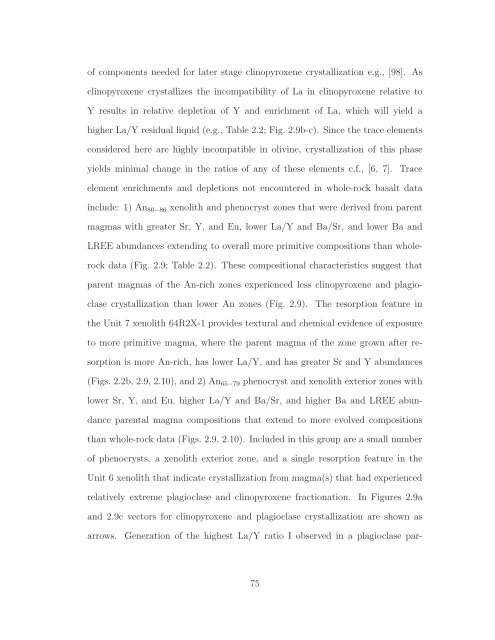TEXTURAL AND MICROANALYSIS OF IGNEOUS ROCKS: TOOLS ...
TEXTURAL AND MICROANALYSIS OF IGNEOUS ROCKS: TOOLS ...
TEXTURAL AND MICROANALYSIS OF IGNEOUS ROCKS: TOOLS ...
You also want an ePaper? Increase the reach of your titles
YUMPU automatically turns print PDFs into web optimized ePapers that Google loves.
of components needed for later stage clinopyroxene crystallization e.g., [98]. As<br />
clinopyroxene crystallizes the incompatibility of La in clinopyroxene relative to<br />
Y results in relative depletion of Y and enrichment of La, which will yield a<br />
higher La/Y residual liquid (e.g., Table 2.2; Fig. 2.9b-c). Since the trace elements<br />
considered here are highly incompatible in olivine, crystallization of this phase<br />
yields minimal change in the ratios of any of these elements c.f., [6, 7]. Trace<br />
element enrichments and depletions not encountered in whole-rock basalt data<br />
include: 1) An80−86 xenolith and phenocryst zones that were derived from parent<br />
magmas with greater Sr, Y, and Eu, lower La/Y and Ba/Sr, and lower Ba and<br />
LREE abundances extending to overall more primitive compositions than whole-<br />
rock data (Fig. 2.9; Table 2.2). These compositional characteristics suggest that<br />
parent magmas of the An-rich zones experienced less clinopyroxene and plagio-<br />
clase crystallization than lower An zones (Fig. 2.9). The resorption feature in<br />
the Unit 7 xenolith 64R2X-1 provides textural and chemical evidence of exposure<br />
to more primitive magma, where the parent magma of the zone grown after re-<br />
sorption is more An-rich, has lower La/Y, and has greater Sr and Y abundances<br />
(Figs. 2.2b, 2.9, 2.10), and 2) An65−79 phenocryst and xenolith exterior zones with<br />
lower Sr, Y, and Eu, higher La/Y and Ba/Sr, and higher Ba and LREE abun-<br />
dance parental magma compositions that extend to more evolved compositions<br />
than whole-rock data (Figs. 2.9, 2.10). Included in this group are a small number<br />
of phenocrysts, a xenolith exterior zone, and a single resorption feature in the<br />
Unit 6 xenolith that indicate crystallization from magma(s) that had experienced<br />
relatively extreme plagioclase and clinopyroxene fractionation. In Figures 2.9a<br />
and 2.9c vectors for clinopyroxene and plagioclase crystallization are shown as<br />
arrows. Generation of the highest La/Y ratio I observed in a plagioclase par-<br />
75
















